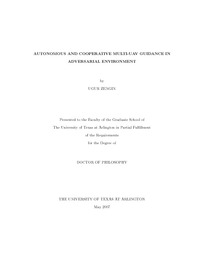| dc.description.abstract | The research presented in this dissertation is aimed at developing
rule-based autonomous and cooperative guidance strategies for UAVs to
perform missions such as path planning, target tracking and rendezvous
while reducing their risk/threat exposure level, and avoiding threats
and/or obstacles by utilizing measurement information provided by sensors.
First, a mathematical formulation is developed to represent the area of operation that contains various types of threats, obstacles, restricted areas,
in a single framework. Once
constructed, there will be no need to distinguish between adversaries as the framework already contains the information on what needs to be avoided and the level of
penalty for a given position in the area. This framework
provides the mathematical foundation for the guidance strategies to
make intelligent decisions during the execution of the mission and
also provides scalar metrics to assess the performance of a
guidance strategy in a given mission.
The autonomous guidance strategies are developed by using a rule-based expert system approach with the requirements of completing assigned mission or task,
avoiding obstacle/restricted-areas, minimizing threat
exposure level, considering the dynamic and communication constraints of the UAVs and avoiding collision.
All these requirements and objectives are quantified and prioritized to facilitate the development of
guidance algorithms that can be executed in real--time.
Cooperation of UAVs is modeled by minimizing a cost function,
which is constructed based on the level of threat exposure for each UAV and distance of each UAV relative to
the target. This improves the performance of the system in the
terms of increasing the total area of coverage of the
sensors onboard the UAVs, increasing the flexibility of the UAVs to
search for better trajectories in terms of obstacle avoidance and threat exposure minimization, and improving the estimation by providing
additional measurement.
Finally, the performances of the algorithms are evaluated in a
simulation environment,
which includes the dynamics of each vehicle involved, the models of sensor
measurement and data communication with different sampling rates, and
the discrete execution of the algorithms. The simulation results demonstrate that
the proposed algorithms successfully generates the trajectories that satisfy the given mission objectives and requirements. | en_US |

